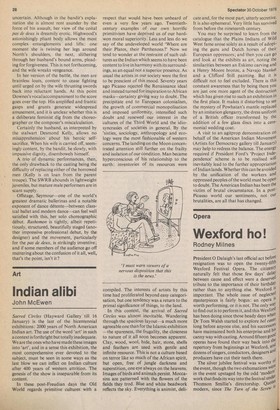Art
Indian alibi
John McEwen
Sacred Circles (Hayward Gallery till 16 January) is the last of the bicentennial exhibitions: 2000 years of North American Indian art. The use of the word 'are in such a context is forthright but totally inadequate. We are the ones who have made these images into 'art', and in a sense this exhibition, the most comprehensive ever devoted to the subject, must be seen in some ways as the last blow we can inflict on Indian culture after 400 years of western attrition. The genesis of the show is inseparable from its content.
In these post-Freudian days the Old World regards primitive cultures with a respect that would have been unheard of even a very few years ago. Twentiethcentury examples of our own horrific primitivism have deprived us of our hardwon moral superiority. Less and less do we say of the undeveloped world 'Where are their Platos, their Parthenons?' Now we tend to wonder at the restraint of such cultures as the Indian which seems to have been content to live in harmony with its surroundings, as an equal not a superior presence. As usual the artists in our society were the first to be prescient of this mood. Seventy years ago Picasso rejected the Renaissance ideal and instead turned for inspiration to African masks—certainty giving way to doubt. The precipitate end to European colonialism, the growth of commercial monopolisation and imposed uniformity, intensified such doubt and renewed our interest in the cultures of the Third World and the idiosyncrasies of societies in general. By the 'sixties, sociology, anthropology and ecology were the most fashionable of western concerns. The landing on the Moon concentrated attention still further on the frailty and isolation of our condition. Man became hyperconscious of his relationship to the earth: inventories of its resources were compiled. The interests of artists by this time had proliferated beyond easy categorisation, but one tendency was a return to the primal significance of things, to the land.
In this context, the arrival of Sacred Circles was almost inevitable. Wandering through the spacious layout--a much more agreeable one than for the Islamic exhibition —the spareness, the frugality, the closeness to nature of it all soon becomes apparent. Clay, wood, wool, hide, hair, stone, shells and feathers are used with gentle and infinite resource. This is not a culture based on terror like so much of the African spirit, but open, free of jungle darkness and superstition, one eye always on the heavens. Images of birds and animals persist. Moccasins are patterned with the flowers of the fields they trod. Blue and white beadwork reflects the sky. Everything is animist, deli cate and, for the most part, utterly secretive. It is also ephemeral. Very little has survived from before the nineteenth century.
You may be surprised to learn from the catalogue that the Plains Indians of Wild West fame arose solely as a result of adopting the guns and Dutch horses of their European oppressors; and then you can go and look at the exhibits as art, noting the similarities between an Eskimo carving and a Henry Moore bronze, a Navajo blanket and a Clifford Still painting. But it is difficult not to feel excluded. There is this constant awareness that by being there yoU are just one more agent of the destruction which has given rise to such an exhibition in the first place. It makes it disturbing to see the mystery of Powhatan's mantle replaced by an imitation glengarry, the dress uniform of a British officer transformed by the addition of a few glass discs into a ceremonial wedding coat.
A visit to an agitprop demonstration on behalf of the American Indian Movement (Artists for Democracy gallery till Januar)) may help to redress the balance. The energY required if President Ford's 'Project Inde' pendence' scheme is to be realised will inevitably lead to the further appropriation of Indian lands. Whether this can be avoided by the unification of the workers and oppressed peoples of the world must be open to doubt. The American Indian has been the victim of brutal circumstance. In a post Picasso world our sentiments, not oar brutalities, are all that has changed.


































 Previous page
Previous page